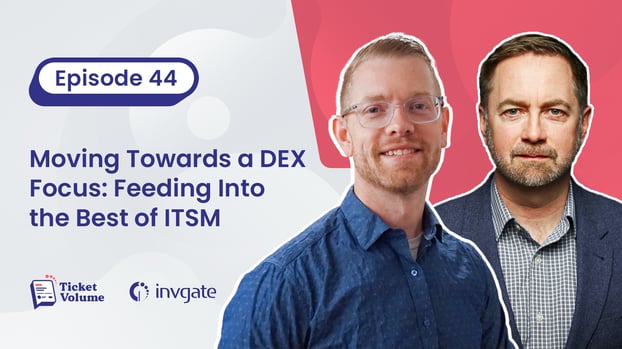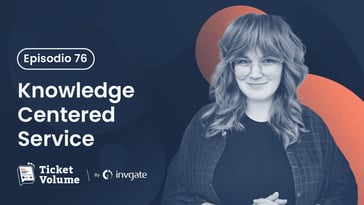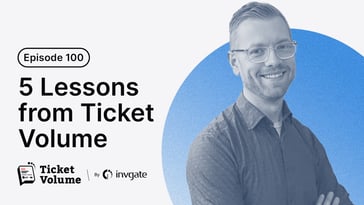Gartner's research predicts that by 2025, half of IT organizations will have adopted a DEX strategy, team, and management tool. This marks a substantial rise from the 15% reported in 2022. The shift is driven by the rising significance of digital tools and technologies at work and the growing understanding of the influence of employee experience on overall organizational achievement.
On that note, Ian Aitchison VP of Product Management at Nexthink, delves into the advantages of adopting a Digital Employee Experience (DEX) strategy in ITSM on the 44th Episode of Ticket Volume, our IT podcast. Take a moment to listen to his insightful guidance on this trending topic and ensure you remain ahead of the competition.
Ian Aitchison holds a prominent position as a Senior Software Product Portfolio Leader and the VP of Product Management at Nexthink. He is a notable public speaker, renowned for his expertise in Digital Experience, IT Service Management (ITSM), Enterprise Service Management (ESM), Automation, Artificial Intelligence (AI), and business technology futures. Additionally, he co-hosts the popular Enterprise Digital podcast.
Don't miss out on the opportunity to tune in to the entire podcast episode featuring Aitchinson. Moreover, you can register for our monthly live recordings, where you'll have the chance to participate and ask questions directly during the session.

Digital employee experience strategy in ITSM
Service management recognizes the increasing value of developing a digital employee strategy, with Nexthink's technology playing a fundamental role in the success of ITSM. Ian has been actively discussing the value of applying concepts from software product management to service management in recent years.
Aitchison went on to say that in the past, software tech vendors focused on building and shipping on-premises software to customers, while service management focused on creating and maintaining running services, often utilizing private cloud or cloud technologies.
However, modern product management has introduced ideas such as empowering product teams, maintaining continuous customer contact, and monitoring technology evolution. Notably, software vendors are now embracing these concepts, aligning themselves with what ITSM was doing previously.
Applying concepts from software product management to service management enables organizations to effectively build and deliver excellent IT services. This integration fosters a more cohesive and streamlined approach, leveraging the best practices from both domains to enhance the overall service experience. And for Aitchison, focusing on DEX is the way to go now.
Understanding DEX tools and integrations
Aitchison gave prominence to cloud operations and DEX as two interconnected concepts gaining attention in the technology market sector. DEX focuses on managing the end-user experience, particularly regarding technology and digital tools. It provides insights into how individuals effectively perform their jobs using technology. For example, HubSpot and Nexthink technologies monitor business applications and provide insights into activity patterns.
|
|
"As tickets come into your service desk, DEX tools can be pre-diagnosing what's going on and updating that ticket and even providing the action to fix that ticket, and even resolving that ticket for you. It's automation, but it's experience-centric automation, making your resolutions line up fast. It's eliminating the causes of incidents and that goes all the way through to support analysts on service management tools working on an incident or a request or a change, and giving insight into the employee's deck score and giving the ability to push fixes and actions." Ian Aitchison |
Its tools closely integrate with Service Management and Unified Endpoint Management (UEM) technologies. These tools bridge the gap between different systems, offering observability into an individual's job performance and sentiment.
- They collect data from various sources, such as devices, applications, and cloud usage, to provide a comprehensive understanding of the user experience.
- Complementing self-service portals, DEX enables studying what works and what doesn't, making changes to services and portfolios.
- These technologies are less complex and come with pre-built content packs for monitoring specific issues.
Utilizing DEX tools allows organizations to get a better picture of how individuals perform their job tasks. This observability includes information about device usage and sentiment, enabling organizations to identify areas for improvement and enhance the user experience. Sharing knowledge and learning from each other's experiences in delivering IT services is essential for continuously improving the smooth operation of systems.
But, above all things, DEX tools and a DEX mindset help improve and prevent incidents in IT. They monitor, detect, and automatically correct issues, preventing them from occurring:
- The tools provide proactive maintenance, catching and fixing problems without user awareness.
- They pre-diagnose tickets, speeding up resolution. Support analysts can leverage them to gain insights and efficiently resolve incidents.
- They offer comparative data for proactive problem management.
- Overall, their technology saves time and effort while enhancing the user experience.
How far ITSM has come to understand the user’s journey
Aitchison gave prominence to the critical need for roadmaps in service management, highlighting their role in enabling professionals to effectively plan and deliver services. Roadmaps serve as essential tools for service management professionals, allowing them to strategically plan and execute their service offerings.
The shift from physical distribution, such as CD-ROMs, to cloud-based services has revolutionized the way roadmaps are planned and executed. This transition has brought about increased flexibility and adaptability in service management, empowering teams to respond swiftly to evolving user needs and market demands.
Now, telemetry plays an essential role, providing enlightening viewpoints into user interactions and outcomes, similar to its role in product management. Telemetry data enables ITSM teams to gain significant perspectives and make informed decisions based on user behavior and preferences.
Frameworks that adapt to the user’s needs
Comprehending the user journey and experience is central to managing services. Similar to product management, the focus is on delivering outcomes that matter to users. The concept of user experience has evolved within this field, highlighting its importance in ensuring customer satisfaction.
Professionals in this field often borrow ideas from other frameworks and methodologies to adapt to changing needs, since there's value in these in multiple spaces. They incorporate concepts from the design life cycle and product management, so they can focus on user needs and deliver services effectively.
For example, the Agile approach has gained prominence, emphasizing incremental steps toward desired outcomes. While taking small steps is necessary, having a clear direction is equally indispensable for effective service delivery. Consistency in delivery ensures that plans are successfully achieved while remaining adaptable to changing circumstances.
|
|
"Every step is for a reason and is taking us in the right direction. (...) Lots of product teams are taking those steps incrementally and sometimes it's a wrong step, and they adjust, and that's fine. But they're all heading towards just a destination we're trying to get to and that's a large part of what the product management side of building technology is about, it's about not doing circular work for the sake of it, but it's about delivering a very clear outcome that's valuable and making sure we deliver it." Ian Aitchison |
It is also true that in product management, delivering clear outcomes is the way to go. Building technology products requires a focus on delivering value. Circular work without a clear purpose is no longer effective. Hence, having a framework around Agile working helps ensure that every step contributes to the right direction and delivers the desired outcomes.
Nevertheless, our guest pointed out that in software development, there are acceptable and unacceptable mistakes. While some mistakes are tolerable, others can have severe consequences, especially in critical areas like building software for passenger planes. Reputation plays a pivotal part in the impact of mistakes, stressing the critical significance of ensuring high-quality and reliable software.
Needless to say, business continuity and disaster recovery are vital aspects of managing services. These practices ensure that operations continue smoothly, maintaining uptime and delighting customers.
On episode 40 of Ticket Volume, Sally Mildren talks about the impact of Employee Experience on revenue. So, if you want to learn more, check it out!
Bottom line
This is just a summary of Ticket Volume's episode featuring Ian Aitchison. There's a lot more to discover in the recording. Be sure to listen to the full conversation with Matt Beran to learn more about top-notch digital employee experience strategy, guidelines that make you think outside the box, and some book recommendations.
You can find the full episode on popular platforms like Apple Podcasts, Spotify, YouTube, or any other podcast platform you prefer. Remember to subscribe if you're interested in joining the monthly live recordings!















